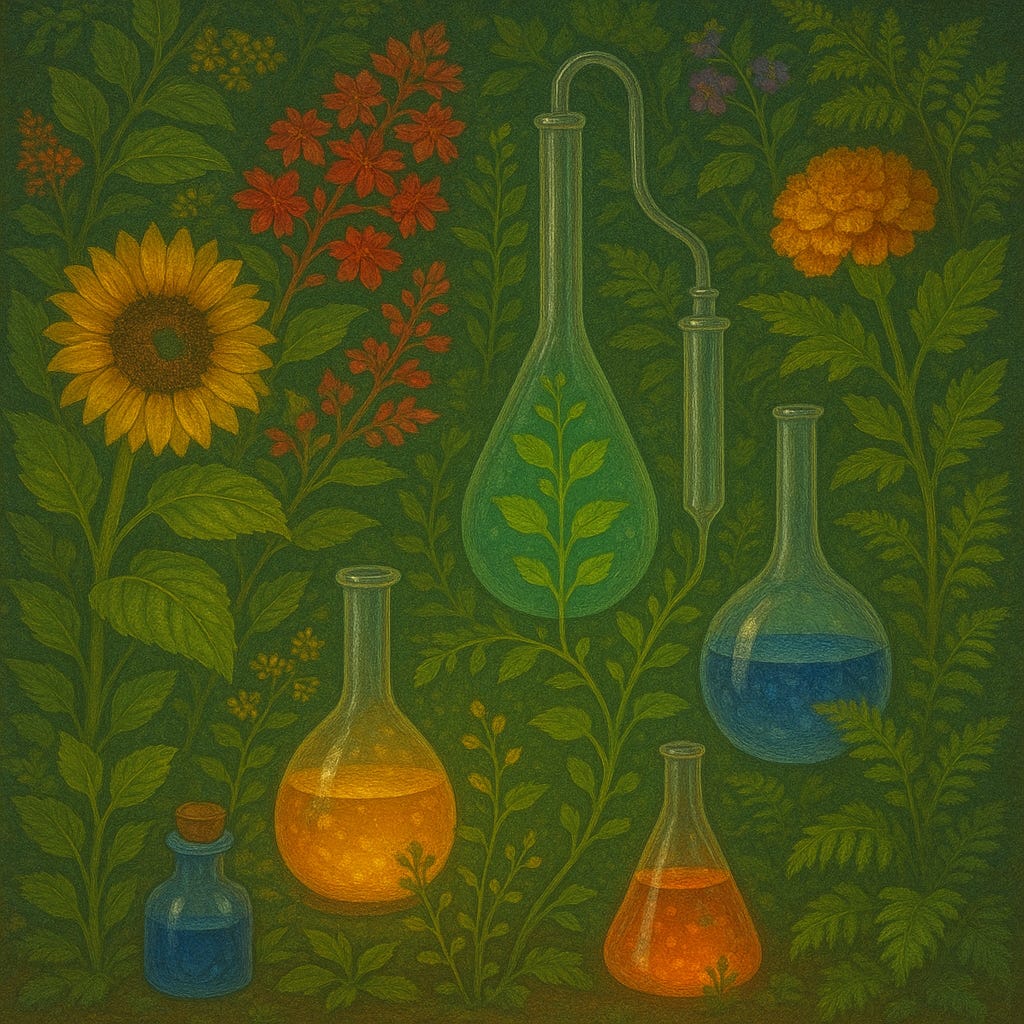Nature’s Beauty Is Not Superficial
Why We Need More Sustainable Ways to Harness Plant Compounds
“If you wish to be rich, do not add to your money, but subtract from your desires.”
- Epicurus
True tranquillity is not found in abundance, but in alignment, in stillness with the Earth, in the deep, silent presence of nature.
My happiest hours are spent with her.
On an untouched shore, I sit alone beneath swaying palms, their fronds murmuring like ancient lullabies. The sky dissolves into molten amber, crimson, and coral, the waves crushing rhythmically near my bare feet.
Or deep within a forest cathedral, where no trace of human presence lingers. Only the trees: tall and timeless, whispering to one another in the wind. Leaves shimmer like dancing green flames.
Nature’s beauty is not ornamental. It is evolved, intelligent. Wisdom in motion. An architecture refined over billions of years. Modest, quiet, complete.
Plants: Nature’s Master Chemists
Within every blossom and branch is a masterclass in biochemical engineering.
Plants produce over 350,000 unique compounds - flavonoids, alkaloids, terpenoids, anthocyanins, and more. These molecules are far from aesthetic whims. They are adaptive tools: pigments that double as sunblock, aromas that attract allies and repel threats, and toxins that defend without war.
Unlike synthetic compounds, which tend to be simplified and petroleum-derived, plant compounds are multifunctional, evolved, and ecologically embedded. They are not blunt instruments, they are symphonies of form and function.
A single lavender flower may contain antimicrobial oils, pollinator lures, and anti-inflammatory agents. A bitter alkaloid from the bark may defend the plant and become a life-saving medicine for us. These molecules do not just interact with their environments, they orchestrate them.
What We’ve Taken, And What We Risk Losing
Many of our most essential medicines come directly from plants:
Vinblastine, a cornerstone chemotherapy drug derived from the Madagascar periwinkle (Catharanthus roseus), is currently in active shortage. As of 2025, 57% of cancer centers report supply disruptions — leading to treatment delays, forced substitutions, and increased toxicity for patients with Hodgkin lymphoma and other cancers.
Artemisinin, a malaria treatment, from sweet wormwood
Aspirin, originally from willow bark
Digoxin, a cardiac glycoside, from foxglove
Morphine, from the opium poppy
These are not outdated discoveries. They are current medical pillars, and many remain unmatched by synthetic alternatives.
What makes plant-derived compounds extraordinary isn’t just their efficacy. It is their co-evolution with human biology. Over millions of years, our systems have learned to metabolise and respond to plant molecules in ways we don’t fully understand yet, because we grew up with them. Our cells recognise them not as foreign, but as kin.
Long before modern pharmacology, ancient systems like Ayurveda and Traditional Chinese Medicine understood this deep affinity. Their use of plant compounds wasn’t reductionist, but relational, treating the body as an ecosystem in conversation with nature. These traditions remind us that plant-based healing is not a trend, but a timeless technology.
And yet, we extract with little foresight. Many species that host these molecules are overharvested, poorly cultivated, or threatened by habitat loss. The beauty and intelligence of nature are being drained, not celebrated.
Toward a New Ethic of Extraction
To preserve these molecules and the ecosystems from which they originate, we must rethink how we access them.
The next generation of plant-based innovation must be sustainable, equitable, and bio-inspired. That means:
Plant cell culture systems to produce key compounds without killing the host species
Gene editing and metabolic engineering to boost yields in less-sensitive plants
Synthetic biology platforms to replicate rare molecules in hosts
Fair benefit-sharing frameworks with Indigenous communities whose knowledge we often rely on
We must transition from extraction to collaboration, from viewing plants as raw materials to recognising them as partners in survival.
Antheia represents a new kind of pharmaceutical future — one that respects the intelligence of nature while building resilience into our healthcare systems. The company is harnessing yeast as a chassis to manufacture pharmaceutical compounds traditionally derived from plants, focusing on tropane alkaloids, benzylisoquinoline alkaloids, and thebaine — essential active pharmaceutical ingredients (APIs). This year, Antheia raised $56 million in Series C financing to advance this mission.
Today, 78% of API manufacturing is based outside the US. Many of these plant-derived compounds are difficult to cultivate, prone to adulteration, and sourced from geopolitically or environmentally vulnerable regions. The result: volatile supply chains, inconsistent quality, and increasing risk.
Antheia’s model offers a path forward — one that is not only scalable and science-driven, but also far more resilient.
Beauty That Heals: The Power of Plant Compounds in Skincare and Supplements
As consumer demand rises for natural, high-efficacy ingredients in both beauty and wellness, many plant-derived compounds are finding dual roles: rosmarinic acid, ursolic acid, and bakuchiol, for instance, are as prized in topical formulations as they are in supplements. Often, the most inefficient business units of ingredient companies is their natural compound sourcing.
But sourcing these compounds at scale isn’t straightforward — some, like squalene, can now be produced cheaply via fermentation; others, like saffron, remain deeply tied to complex plant biosynthesis that is difficult to replicate outside the plant.
This is where biotech-enabled manufacturing platforms will become increasingly vital: offering a path to maintain the integrity and potency of these bioactives without overharvesting rare or vulnerable species and onshoring US production to build domestic supply chains.
Whether for skincare or pharmacology, the next era of botanical innovation will be defined not by imitation, but by intelligent preservation.
“Nature is the only book that offers valuable content on every page”
- Goethe
We cannot continue turning nature’s library into a strip mine.
Every flower, bark, root and resin carries knowledge, if we approach it not as conquerors, but as students.
Plants are the original chemists. The original artists. The original healers. To design a future that is wise, ethical, and sustainable, we must learn to listen again.
Because nature’s beauty is not superficial. It is a blueprint for survival.







Reminds me so much of content from the https://www.pharmacognosy.us/ conference (tho they tend to be deep in only a small number of plants). Love this post as a super-vegetarian person btw!!